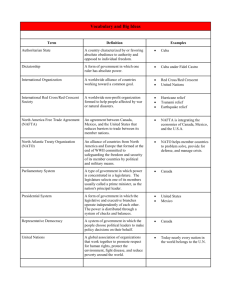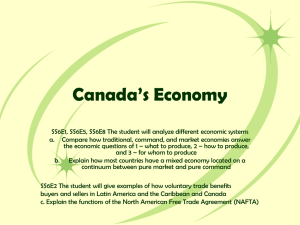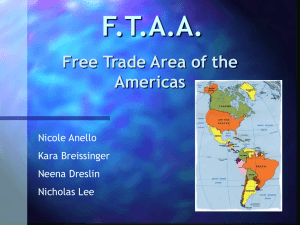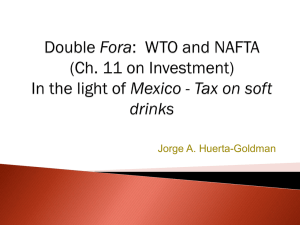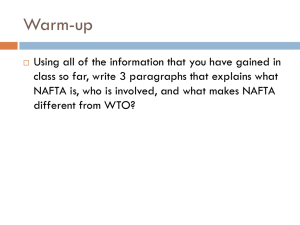Mexico after 10 years of NAFTA: The price of going to market
advertisement
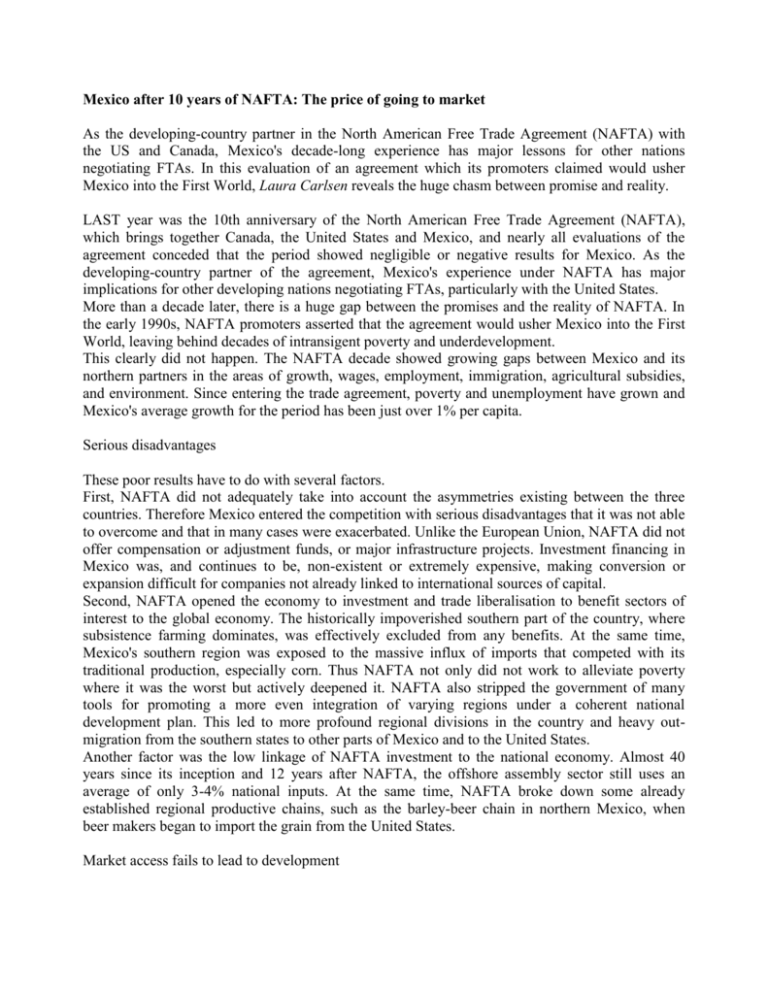
Mexico after 10 years of NAFTA: The price of going to market As the developing-country partner in the North American Free Trade Agreement (NAFTA) with the US and Canada, Mexico's decade-long experience has major lessons for other nations negotiating FTAs. In this evaluation of an agreement which its promoters claimed would usher Mexico into the First World, Laura Carlsen reveals the huge chasm between promise and reality. LAST year was the 10th anniversary of the North American Free Trade Agreement (NAFTA), which brings together Canada, the United States and Mexico, and nearly all evaluations of the agreement conceded that the period showed negligible or negative results for Mexico. As the developing-country partner of the agreement, Mexico's experience under NAFTA has major implications for other developing nations negotiating FTAs, particularly with the United States. More than a decade later, there is a huge gap between the promises and the reality of NAFTA. In the early 1990s, NAFTA promoters asserted that the agreement would usher Mexico into the First World, leaving behind decades of intransigent poverty and underdevelopment. This clearly did not happen. The NAFTA decade showed growing gaps between Mexico and its northern partners in the areas of growth, wages, employment, immigration, agricultural subsidies, and environment. Since entering the trade agreement, poverty and unemployment have grown and Mexico's average growth for the period has been just over 1% per capita. Serious disadvantages These poor results have to do with several factors. First, NAFTA did not adequately take into account the asymmetries existing between the three countries. Therefore Mexico entered the competition with serious disadvantages that it was not able to overcome and that in many cases were exacerbated. Unlike the European Union, NAFTA did not offer compensation or adjustment funds, or major infrastructure projects. Investment financing in Mexico was, and continues to be, non-existent or extremely expensive, making conversion or expansion difficult for companies not already linked to international sources of capital. Second, NAFTA opened the economy to investment and trade liberalisation to benefit sectors of interest to the global economy. The historically impoverished southern part of the country, where subsistence farming dominates, was effectively excluded from any benefits. At the same time, Mexico's southern region was exposed to the massive influx of imports that competed with its traditional production, especially corn. Thus NAFTA not only did not work to alleviate poverty where it was the worst but actively deepened it. NAFTA also stripped the government of many tools for promoting a more even integration of varying regions under a coherent national development plan. This led to more profound regional divisions in the country and heavy outmigration from the southern states to other parts of Mexico and to the United States. Another factor was the low linkage of NAFTA investment to the national economy. Almost 40 years since its inception and 12 years after NAFTA, the offshore assembly sector still uses an average of only 3-4% national inputs. At the same time, NAFTA broke down some already established regional productive chains, such as the barley-beer chain in northern Mexico, when beer makers began to import the grain from the United States. Market access fails to lead to development One of the biggest disappointments of NAFTA has been in the area of expectations of increased market access. Access to the US market - the largest in the world - has always been the grand allure of FTAs with the United States. In the 1990s, the Mexican government was convinced that profound integration into the world economy was the only ticket to national development, and that the United States was the ideal if not only partner to achieve this. The government conceded considerable ground to obtain access that they claimed would serve to reorient the Mexican economy outwardly based on its absolute and comparative advantages. More and more we are seeing, however, that access to the US market is poor compensation for the concessions that Latin American governments are required to make in FTAs with the United States. One reason for this failure is that the United States picks and chooses what access to give, while demanding near-total liberalisation for entry of its own products. The United States routinely maintains protections in the form of quotas and non-tariff barriers that it rarely allows for its trade partners. Given the US surplus production in key agricultural products and the impact of imports on small and medium industries that produce for the domestic market, the social, economic, and political costs of domestic markets lost to cheap, often subsidised imports are very high. Moreover in the current context, the export advantages of FTAs with the United States are likely to be short-lived. As the United States negotiates FTAs and trade liberalisation rules with nations all over the world, the privileged access of its previous partners becomes less of a competitive edge. For example, a recent study indicates that the Central American Free Trade Agreement will do little or nothing to alleviate the plight of the Central American textile industry in the face of the end of the multi-fibre pact and the influx of Chinese exports on the world market. Likewise Mexican economic officials warn that Mexico is losing its ability to compete in offshore production for the US market and will continue to lose as other countries offer an even cheaper labour force and transportation costs decrease. Thus, even the limited dynamism in trade and investment that resulted from NAFTA is likely to fade considerably in the coming years, according to the government itself. Farm woes Agriculture offers the best example of the fallacy of the argument that market access can achieve major development goals. Since market access goes both ways, access to the US market for Mexican fruits and vegetables led to high growth in the horticulture sector but came at the expense of losing national markets for other products. While Mexico experienced over 50% growth in the value of its exports of major fruits and vegetables to the United States, the earnings have been more than offset by the cost of its burgeoning imports in grains, especially corn, which tripled. Some domestic sectors have been virtually wiped out - a recent study notes that 99% of soybeans are imported and wheat cultivation fell by half. With imports accounting for 80% of rice, 30% of beef, pork, and chicken and a third of Mexico's staple - beans, serious concerns about food dependency have arisen. The benefits of fruit and vegetable export have been limited to a very small number of large farmers concentrated in the northern part of the country, while grain imports have devastated thousands of farm livelihoods throughout the country. Nearly two million farmers have left the land since the onset of NAFTA, eight of every 10 live in poverty, and 18 million earn less than $2 a day. The displacement caused by massive imports can be difficult to calculate and compensate. Mexican planners anticipated a need for maize farmers to convert but overestimated the growth of livelihood alternatives in other sectors and underestimated cultural resistance to abandoning rural communities. The result was emigration to the United States, rural poverty, increased illegal drug production in some regions, and intensification of farm labour, especially for women. Moreover, liberalised corn imports had an impact on other crops as well. As the price of corn dropped, livestock producers converted to corn as feed, causing devastation in the sorghum sector. Similarly, although Mexico does not import white corn, processors replaced it with cheap yellow corn in foodstuffs, eroding the domestic white corn market. Providing access for US agricultural products, instead of 'levelling the playing field' as US trade negotiators claim, allows severe distortions in the value of these goods since many US exports are so heavily subsidised. The 2002 US Farm Bill authorises an 80% increase in subsidies over the next 10 years. The United States has refused to discuss its agricultural subsidies in every one of the bilateral FTAs negotiated to date. Due to these subsidies, particularly grains are being sold on the international market with dumping margins of 25% or more. This puts domestic production in developing countries, where these grains constitute not just products but the staples of the local diet, at an unfair disadvantage. The resulting dependence on imports also poses a serious threat to food security and sovereignty. Finally, NAFTA did not even necessarily assure fair market access. In key horticultural crops and others, Mexico has met with protectionist measures from the US in the form of dubious phytosanitary barriers, anti-dumping complaints, and other pretexts. The US government also has no qualms about protecting sectors it considers politically strategic. New free trade agreements: CAFTA and AFTA NAFTA was negotiated over a decade ago. Since then, many countries in Latin America have seen the growth of civil society movements in opposition to the NAFTA trade model. The governments of several nations, notably Brazil, Venezuela, Argentina, and Uruguay, have criticised the model and urged modifications while emphasising alternative forms of regional integration like Mercosur (the Southern Common Market which comprises Brazil, Argentina, Uruguay and Paraguay). The Free Trade Agreement of the Americas (FTAA) is at an impasse. In this new context, has the United States changed its negotiating style or stance? The answer, with few exceptions, is no. Instead of heeding this wave of opposition, the United States has dug into its trenches, and in economic policy those trenches are the bilateral trade agreements. From the FTAs, the US government hopes to gain the strength to launch renewed trade offences in broader multilateral organisations like the WTO and any eventual FTAA. Each NAFTA-style FTA signed not only locks the partner country into a series of pro-corporate measures but also sets a precedent for later negotiations. This summer the US Congress ratified the Central American Free Trade Agreement (CAFTA). The time it took to negotiate and ratify this agreement was much longer than what the Bush administration had anticipated. Some of the problems are illustrative of what's in store for future negotiations. In the end CAFTA is indeed a close cousin of NAFTA. Despite being given side-room status, for example in El Salvador, civil society actors failed to modify the agreement. Their proposals were consistently squelched either by the negotiating teams of their own governments or US refusals. Popular protest broke out in most of the nations involved, led by farmers and labour organisations. The political costs for the governments involved are high. Just as the Bush administration was forced to delay ratification in the US Congress due to lack of votes, Central American governments fear ratification will meet with major opposition in their legislatures and in the streets. In Guatemala, the CAFTA debate took a life when a demonstrator against ratification was killed by police. Nicaragua, the Dominican Republic, and Costa Rica still have not ratified, and the Costa Rican president is said to be waiting out his term to pass the hot potato on to his successor. Demonstrations against the incorporation of the telecommunications sector in that normally docile country nearly caused Costa Rica to pull out of the agreement. In the Andean countries, the situation is even worse. Bolivia is out of the picture because a showdown over the Andean Free Trade Agreement (AFTA) could easily cause the fall of yet another government, caught between the dictums of the economic model and the anger of a people fed up with empty promises. Venezuela under the US nemesis, Hugo Chavez, has denounced all prospects of an FTA with the United States. Both Ecuador and Peru face possible referendums on the issue in their countries and may be barred from participating anyway by the United States, which - acting openly as a corporate advocate rather than a government - has premised their participation on resolution of several cases of investor claims by major US transnationals. Playing hardball In both CAFTA and AFTA, rather than take a conciliatory stance faced with the probable negative and destabilising impacts of the agreements, US negotiators have played hardball. First, they threatened to withdraw or not renew the current trade preferences these countries enjoy - under the Andean pact for Trade Promotion and Drug Eradication in the Andean case and the Caribbean Basin Initiative and others in Central America. Since many industries had already oriented production toward markets assured under these measures, the threat had real weight. Even government officials have complained that in effect the FTA process means that these nations are forced to concede in non-trade areas such as intellectual property and investor protection only to assure the market access they already have. Negotiating teams in several countries have complained that the United States gives little and asks a lot. Rice has been particularly sticky. The Central American agreement allows 10 years for tarifffree entry but farmers argue that time is not the problem - US subsidies make it impossible to compete, ever. Andean countries are being pressured to increase their quotas for US rice although a study by the Latin American Economic Commission recommends the total exclusion of rice from the agreement be considered due to the pivotal role of rice as a source of food and employment. Some lessons learned 1. The trade-offs between gaining greater access to the US market and the displacement caused by loss of national markets to imports often lead to negative net results. When compounded by a decrease in participation in other regional and global markets, the result is both politically and economically negative. 2. Concessions to US demands in FTA negotiations can have long-term detrimental effects. Mexico has seen the erosion of the smallholder farmer economy, the loss of traditional knowledge of land and biodiversity use in rural communities, food dependency, obstacles to the construction and consolidation of South-South links, and greater inequality in income distribution. It is also losing national sovereignty, cultural diversity, and important policy tools for national development. 3. Special product protection, safeguards, or longer liberalisation periods are insufficient to solve the problems caused by massive imports. A strategic product cannot be left to distorted market forces. Moreover, the examples of sorghum and white corn displaced by yellow corn imports illustrate the insufficiency of offering special protection to specific products. 4. The FTAs with Mexico, Chile, Central America, and potentially the Andean region severely hamper the development of other potentially more advantageous options of economic integration. The value of regional integration is not merely to create a trading bloc to compete and negotiate more effectively with developed countries but to rethink regional integration and develop joint tools for sustainable production and trade. When done ideally - in a more horizontal manner, among nations that share common challenges, with national development and well-being cast as primary goals - regional integration could be a far more equitable and sustainable course than the FTA model currently imposed by the United States. 5. Washington's divide-and-conquer strategy forces nations to concede in other areas in order to assure market access, and uses sticks over carrots to impose a model that benefits US economic and security interests and large corporations. For this reason, FTAs with the United States should be avoided. Nations must evaluate alternative forms of economic integration and assess all options. The gains offered are limited and short-lived; the price is likely to be the long-term sustainability and stability of the country. Some final caveats For nations entering into free trade negotiations with the United States, Mexico's experience provides some additional caveats. The first regards the need to incorporate the silent voices in the negotiations process and debate. Large industrialists typically come to the table with considerable influence and a convincing case we make this, we need a market, the United States offers the largest in the world, ergo we need an FTA with full market access. But market access cuts both ways and never constitutes an unmitigated gain for a developing country. Gain in access to the US market can be offset by the loss of the developing country's own domestic markets in key sectors. Small producers, especially farmers, are particularly vulnerable and have a weak voice in national politics. Incorporating them into talks is necessary not only to enhance democracy and transparency but also to arrive at a better agreement. They hold important truths about the productive and social structures of their countries. Second, not all costs are quantifiable and among the highest costs of FTAs with the United States today are the political costs. In US FTA negotiations, everything - trade being often a minor issue is on the table, whether explicitly or implicitly. And in the centre is the renewed US drive for global hegemony. Trade policy is an instrument for this hegemonic control, and it is now closely tied to security policy. Political costs of trade dependency on the United States can be very high. In the 'with us or against us' mentality of the war on terrorism, trade relations become another lever of control. Mexico learned this when, as a rotating member of the UN Security Council, it faced extreme pressure to break its tradition of non-intervention and support the US invasion of Iraq. Another cost is the erosion of possibilities for greater regional economic integration. Finally, it is important to remember in any cost/benefit analysis that many sectors produce values that will never be reflected on the international market but that are vital to developing countries and the world. These include livelihood generation, cultural diversity, food sovereignty, protection of ecosystems, and biodiversity. To fully incorporate these values requires going back to a basic guiding principle. We must invert the current equation that has trade policy driving national development policy - or in many cases supplanting national development policy since many governments no longer formulate real national development policies - and assure that trade policy serve sustainable and equitable national development goals. Laura Carlsen directs the Americas Program of the International Relations Center, online at www.irc-online.org. The above is based on presentations by the author at the Asian Regional Workshop on Bilateral Free Trade Agreements, held in Kuala Lumpur on 26-28 August and organised by the Third World Network. Comments welcome at laura@irc-online.org.


